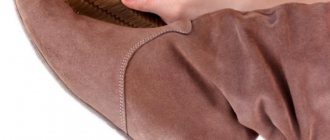Everyone knows that shoes should be stored according to certain rules, but not everyone follows these rules. What should you do so that by the next season your shoes do not warp, do not dry out and have a presentable appearance? Everything is very simple: it is first cleaned of dirt, washed, treated with antiseptics and softening agents. And only after that they put it in a box in which it will be stored until the next season. This is a general principle for all shoes. Let's take a closer look at how summer and winter shoes are stored.
General cleaning
It is not enough to simply wipe your shoes with a cloth and put them in the closet. There are 5-7 long months of heat and active insect life ahead. To prevent your favorite boots from deteriorating during this period, you must first clean them well.
Dirt on boots and traces of sweat on insulation are food for bacteria and fungus. In addition, “odorous” pollution attracts insects.
Therefore, you need to carefully clean your favorite pair before storing:
- It is necessary to wash the inside of the boots. To do this, use liquid detergents for wool. They rinse well and do not clog the material like powders and soaps.
- The insole should be properly removed before the procedure. It is replaced with a new one or washed separately.
- The detergent is diluted according to the instructions. The temperature of the soap solution should not exceed 30 degrees.
- Next, the solution is poured into the shoes and left for 5 minutes.
- They go through the inside of the boots with a brush.
- Rinse with clean water and dry.
- The outside of the shoes is cleaned with soft brushes, and suede and nubuck are cleaned with special cleaning foam.
Winter shoes, especially leather and suede, should not be in contact with water for too long. You need to wash them in 15-30 minutes.
Advice. If the inside of the boots is relatively clean, you can not wash them inside, but vacuum them and treat them with an antiseptic shoe spray.
Storage options
Common questions: is it possible to store shoes on the balcony in winter simply in boxes, how to hide them from the sun, and save space. I don’t want to see a pile of boxes when I look out the window.
Wardrobe or chest of drawers that closes
The best solution for a large balcony or loggia is cabinets, chests of drawers, closed bedside tables. Old furniture will do. If desired, it is easy to paint and paste over it. Drawers and shelves do not replace the need for proper packaging. It will protect shoes from high humidity in winter, autumn, and early spring.
The second point is that large stacks cannot be stored; the bottom rows of cardboard boxes are deformed from the weight. When using a wardrobe, we recommend building shoe shelves with your own hands. They are easy to make from chipboard, plywood, and sheathing.
Instead of shelves in closets, you can use hanging organizers and old bookcases.
Racks or shelves
It is not necessary to take cabinet furniture out onto the balcony. Lightweight structures are suitable - shelves, racks. There is just one point - shoes need to be protected from sunlight even in winter. Additional containers and boxes will be required.
You can build a rack with your own hands, make curtains, a screen. Or play with the height, place the shelves below in a place protected from the sun.
Treatment with protective compounds
In summer, the shoe material can dry out, become hard, rough, and crack.
Natural insulation is often attacked by moths. To keep shoes looking fresh after seasonal storage, you need to:
- Treat the outside with a care product. Genuine leather and leatherette are rubbed with shoe polish. For suede and nubuck, aerosol products are used. Treatment prevents moisture loss and roughening.
- Use a moth repellent: special balls, sochettes, sprays. Modern drugs are odorless. For example, “Anti moth” or “Armol Expert” aerosols have virtually no odor, and at the same time repel moths for 5 months. You can process the boxes in which shoes will be stored.
Advice. If your shoes have lost their color, it's time to touch them up. You can use the services of a repair shop or purchase a can of shoe paint and perform the procedure yourself; small scratches can be painted over with a felt-tip pen.
How to clean shoes before storage
In winter, shoes are the first to take the blows of bad weather and are exposed to salt and sand. Even the highest quality materials will suffer after three to four months of such use. Before long-term storage, we recommend restoring them by washing and soaking them in special creams.
Do not completely insert your shoes under the running water. Ideally, purchase cleaning products from specialized stores. They will remove traces of reagents and greasy stains, while the impact on the material itself will be minimal.
After washing, the shoes should be dried thoroughly. To maintain its shape when drying, we recommend placing newspaper or wooden blocks inside.
Complete drying
After general cleaning, the shoes should be dried thoroughly, preferably with an electric dryer. The sole must also be dry and clean.
We recommend: How to reliably store bell peppers at home for the winter
Before summer storage, shoes are dried for at least 8 hours in a dryer and another 24 hours in a ventilated room. People often rush to pack their winter boots. Such a mistake is fraught with the appearance of an unpleasant smell of dampness and mold. It should be taken into account that the last thing to dry is not the insulation, but the area between the sole and the insole. You cannot judge the dryness of boots by appearance or even by touch. Droplets of moisture may remain inside. It’s better to play it safe and let your shoes dry for an extra day.
Advice. If you plan to store your winter boots in a damp place (which is not recommended), put 2-3 packets of silica gel inside.
You can replace the silica gel with socks filled with coarse rock salt or plain rice.
Preparing the inside of the shoe
After you have cleaned the top of the shoe, start preparing the inside. Pull out the insoles. Wash them thoroughly and dry them. If moisture gets into the shoes, or your feet sweat in warm socks, then the insoles remain wet for a long time. To prevent mold from growing on them, they must be washed and dried. Place a few pieces of cotton wool soaked in vinegar diluted with water into your shoes. Place the boots in sealable plastic bags and leave for 12 hours. This will help get rid of the unpleasant odor.
Anti-deformation
Proper preparation of winter shoes for storage includes the use of shoe lasts. They come in plastic and foam. In general, the material is not very important. If there are no special lasts, you can stuff your shoes with newspapers or office paper. The main thing is that they are not stored flattened.
It is recommended to insert inserts into the tops of boots:
Proper preparation is the key to success
If you do not have a dressing room in which each pair has its own place, you will have to think about how to store winter shoes, summer sandals and shoes in the off-season. To do this, you need to determine the location and storage conditions, select suitable means for processing, etc. But the most important thing is to carefully prepare each pair. To do this you need:
- Wash with a brush and cleaning products.
- Dry according to the manufacturer's recommendations (it is not recommended to leave it on a radiator or electric heater; exposure to direct sunlight also has a negative effect on shoes).
- Treat with special creams and protective compounds.
- Prepare packaging for seasonal storage. Traditionally, these are branded cardboard boxes with a hole for ventilation. They close tightly and prevent the penetration of sunlight.
Important! Each pair needs its own separate storage space. It must be remembered that without prolonged use, the leather on shoes dries out, so shoes need to be filled with paper or special mold holders must be used.
Restoring elasticity after long-term storage
Have you put away your winter boots? It's time to get the spring one. Perhaps last season you were not aware of some rules, and your shoes lost their attractiveness. Not scary. The lost gloss can be restored.
To do this, treat your shoes with oil impregnation or its analogues from household use:
- vegetable oil,
- rubber glue,
- Vaseline,
- glycerin,
- oil varnish.
Don't forget about regular care and proper storage, and your shoes will serve you for many years!
Proper care
The basis of proper storage is keeping shoes clean and regularly ventilating them. Things without contamination last much longer, so when you come home from the street, follow the following rules every time:
- After taking off boots or shoes, clean them each time from dirt according to the care rules.
- Apply special products to your shoes that correspond to the material from which they are made.
- Dry boots and boots at room temperature or using special dryers, without resorting to heaters.
- Take out the removable insoles to dry them separately.
How to store shoes at home
It is not recommended to leave your shoes in the hallway all winter or summer. First of all, they will take up extra space and create a feeling of clutter. In addition, in an open place they will quickly become covered with dust, and they will have to be wiped every few days.
Convenient shoe storage can be organized using both purchased devices and simple home-made storage units.
Shoe storage devices
Among the purchased devices, we can list several of the most popular ones. They are inexpensive and easy to find.
Shoe maker
The simplest idea for storing shoes in the hallway is an ordinary shoe rack. A small open or closed bedside table is inexpensive, takes up little space, and is very convenient to use. The shoe rack is placed in the corner of the hallway or in the dressing room, boots, boots and shoes are placed in any order on its shelves. In this case, they are stored in one place, always at hand, but not conspicuous and do not interfere with movement around the apartment.
Shoe rack is the most common shoe storage option.
Rotating stand
Such racks are usually used to display goods in supermarkets, but they are also ideal for storing shoes, especially if we are talking about lightweight shoes, ballet flats or sneakers. An additional advantage of the rack is that storing shoes vertically allows you to save space to the maximum. The disadvantage of the device is the open design; from time to time, shoes will have to be wiped clean of dust.
Vertical rack for shoes and ballet shoes takes up very little space
Shoe organizer
The idea of compact shoe storage suggests using shoe organizers; they can be made in a variety of forms. Sometimes they are a hanging structure with roomy “pockets”, sometimes they look like laconic pins on which you can put shoes by turning them upside down. Organizers of any type are convenient because they are suitable for use even in very cramped apartments and allow you to store a large number of shoes in literally half a meter of space.
The shoe organizer can be hung anywhere in the apartment
Attention! The most common option for storing shoe products are store boxes. Those in which the shoes or boots were purchased. However, they have a drawback - the boxes take up quite a lot of space.
Homemade shoe storage devices
If you can’t buy store-bought devices, or you simply don’t want to spend money on them, you can make convenient storage devices with your own hands. It takes little time, and the designs themselves are extremely simple.
We recommend reading: Is fluoride in toothpaste harmful, its role in the body
Hangers with clips
The original idea of storing shoes in a closet suggests hanging boots and shoes on hangers with clips, rather than placing them. The clips are carefully secured to the top of boots, boots or fabric sneakers and sneakers and the hangers are placed in the closet.
You can hang boots and long shoes on a hanger
The advantage of the device is that the products in this case retain their shape well and do not wrinkle. However, you should not store shoes in a closet without boxes on hangers if the tops of the products are leather. In this case, it is better not to use clips, but simply hang the products on hangers in fabric bags.
Empty paint cans
Large cans that once held paint are good for storing compact shoes, sneakers, ballet flats and sneakers. The jars need to be thoroughly washed and the smell of paint removed, and then secured to the wall in even rows and the products placed inside. This idea is convenient for storing children's shoes, which are small in size.
The design is well suited for a pantry, where the jars will not disturb the harmony of the home interior.
Empty tins work well for storing flip-flops and sandals.
Crossbar against the wall
Among the photos of options for storing shoes in the hallway, you can often find a very simple device - a bar attached to the wall at a short distance. It is especially convenient to place women's boots, shoes and boots with heels on the crossbar. It is the heel that hooks the product to the support, thanks to which it holds firmly on the bar and does not fall.
Planks against the wall - a compact option for placing shoes and boots











